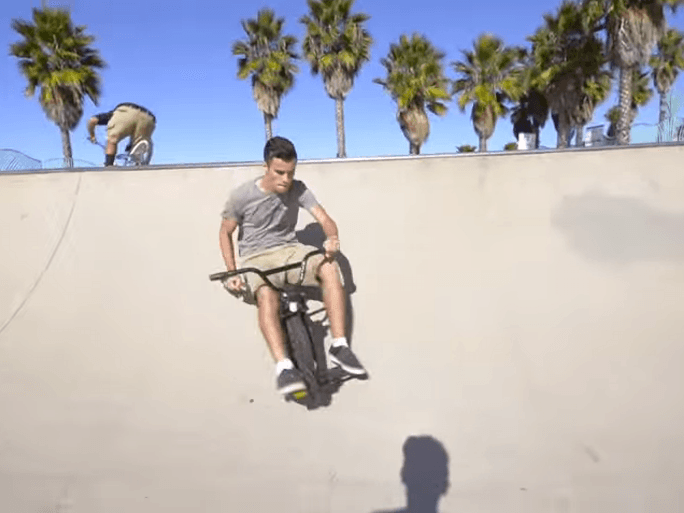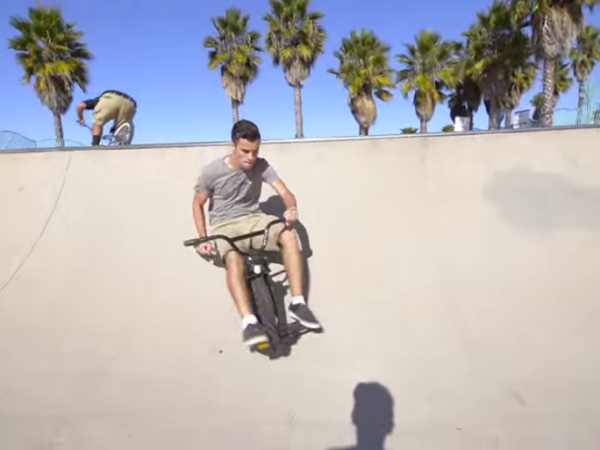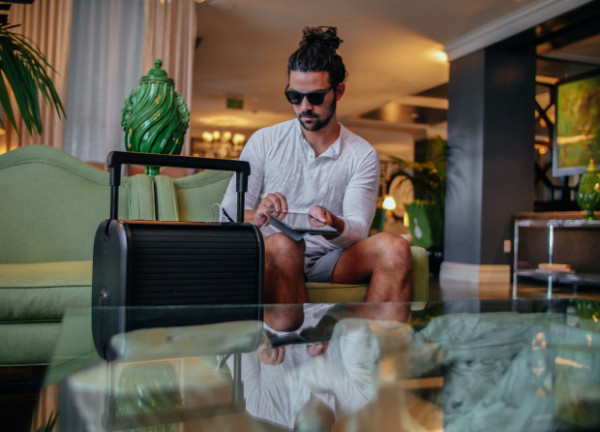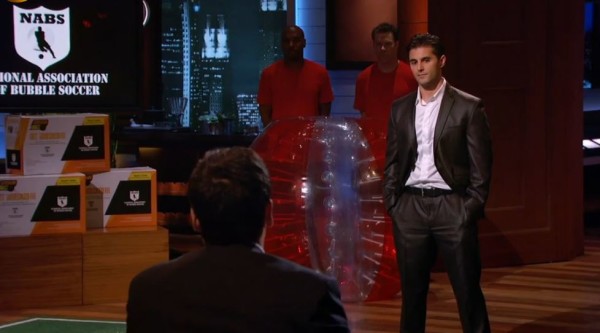
 After a week break, Shark Tank returned to ABC with a new batch of entrepreneurs. Sharks Mark Cuban, Barbara Corcoran, Kevin O’Leary, Lori Greiner and Robert Herjavec were presented four pitches from up-and-coming businesses looking for an investment. From knit handbags to racing tricycles, the Sharks were given diverse options on ventures that they could help fund and develop.
After a week break, Shark Tank returned to ABC with a new batch of entrepreneurs. Sharks Mark Cuban, Barbara Corcoran, Kevin O’Leary, Lori Greiner and Robert Herjavec were presented four pitches from up-and-coming businesses looking for an investment. From knit handbags to racing tricycles, the Sharks were given diverse options on ventures that they could help fund and develop.
So here is a recap of tonight’s pitches:
Leaux Racing Trike
Asking: $120,000 for 20%
Tyler Hadzicki raced on in with the latest innovation in biking, the Leaux Racing Trike. These bikes are designed similar to a children’s 3-wheeled tricycle. However, they have been altered for more extreme use and relatively high-speed action. The bikes are designed so that the driver is at the lowest possible seating position, with the pedals placed at the very front tire.
Initially, Tyler created the bike for his high school science project. However, after he won first place at a San Diego science fair, he realized he might be on to something. Shortly after, Tyler created a Kick Starter campaign that raised over three times more money than his specified goal. The bikes are sold for $350 and cost approximately $170 to make.
Unfortunately, both Kevin and Barbara drop out, as they don’t see the scalability of the niche product. Meanwhile, Lori advises him to look into licensing down the road but also drops out. Robert says that he needs to determine his true target market, either the kids or the hardcore riders. Soon after Robert drops out, followed by Mark Cuban.
Thus, Tyler walks out without an investment.
Glow Recipe
Asking: $425,000 for 10%
Co-creators Christine Chang and Sarah Lee are New York-based businesswomen who are hoping to bring Korean beauty products to the American market. Glow Recipe is a line of beauty products that are specially formulated using traditional Asian ingredients – such as kelp.
The women explain to the sharks that they use their experience from working for L’Oreal to curate which products they believe are suitable for the US market. Although they don’t make the products themselves, they feel that they have the special touch that will allow them to successfully infiltrate the market.
The Sharks are impressed as Christine tells them they went from $3,000 in the first two months to making over $500,000 in the 10 months following this. In addition, they are on track to do $1 million this year.
Barbara is the first shark to offer, at $425,000 for 40%. Shortly after, Kevin offers $425,000 for 50% and then Robert comes in at $425,000 for 30%. Unfortunately, Lori says that the cosmetic business is too competitive and drops out.
Christine and Sarah end up accepting Robert’s deal, as he drops down to $425,000 for 25%.
Sarah Oliver Handbags
Asking: $250,000 for 25%
Sarah Oliver created a business around her passion for knitting. She hired a team of senior citizens (referred to as the Purlettes) to help her create hand-knitted handbags.
The company description explains, “the Purlettes + 1 are the backbone of Sarah Oliver Handbags. They are the coolest, most inspiring group of men and women – average age 88 – and we feel like the luckiest team in the world to get to work with them. The founding group nicknamed their selves The Purlettes +1, so named for their “knit one, purl two” expertise, as well as the pearls of wisdom they impart. The +1 represents the sole male knitter, Hector.”
In each bag, there is a tag that explains the story of the elderly citizen who knitted it. The bags are pretty high-priced, as they cost about $47 to make and sell for $225. To date, she has earned $1.9 million in revenue.
Lori really admires the business and tries to get all the sharks to go in on a deal. Lori offers $250,000 for 25%, with each shark paying $50,000 for 5%. Lori explains she hopes to make a statement by getting all the sharks in the deal.
Unfortunately, Mark, Kevin, and Barbara aren’t feeling as giving and drop out. This leaves Lori and Robert in, but Sarah asks Mr. Wonderful to come back in. Kevin agrees but increases the equity to 30%.
Therefore, Sarah makes a deal with Lori, Robert and Kevin at $250,000 for 30%.
Trunkster
Asking: $1.4 million for 5%
The last pitch of the night was from Gaston Blanchet and Jesse Potash, the creators of Trunkster. Trunkster is a luggage line that includes GPS, a charger for mobile products, roll-top access, built-in scale and a sturdy handle. It is an innovation that hopes to reduce the stress that many travelers face when dealing with luggage.
Unsurprisingly, the sharks are taken back by their $28 million valuation, especially since they are currently pre-revenue. However, Gaston explains he has full confidence in the concept, as they became the most successful travel campaign in Kick Starter history (raising $1.4 million). In addition, they have already collected $2 million worth of orders.
With all of the innovative features, the product sells for $395 and costs about 20% of that to make. Their plan is to sell their product only online.
Unfortunately, all of the sharks are impressed with the concept, but they aren’t happy with the valuation. Robert tells them they are worth about $3-5 million at this point.
Barbara is the first shark to drop out because she feels the product is too masculine and bulky. Afterward, Robert offers the entrepreneurs $1.4 million for 30%. Kevin follows and offers them $1.4 million for 37%. Lori is nervous about the risk associated with the idea but agrees to give them $1.4 million for 15%.
Ultimately, the guys try to negotiate a deal with Mark and Lori. They offer them 5% for $1.4 million, with a promise to pay them back their total investment within 24 months. If they are unable to do so, Mark and Lori’s equity will increase to 10%. In addition, after they are paid back, Mark and Lori will receive $1 royalty per unit sold.
Lori and Mark agree to Gaston and Jesse’s offer, and they close the deal.
What’s interesting with this one is that it’s not all original as luggage that was similar was pitched on Science Channel’s All-American Makers. This one was to help make you be able to carry more things in your luggage along with the USB ports.
You can catch a new Shark Tank next Friday, December 11 on ABC.
Next Week:
Shark Tank embraces the holiday season, as it features animated glow balls with synchronized musical trees, whimsical knit hats, pop-up greeting cards and natural deodorant that features charcoal.
Bubble Soccer John Anthony Radosta Bounces Back After A Shark Tank Pass:
Bubble soccer started out as a gag on a Norwegian TV show. Thanks to YouTube’s viral magic, it exploded into a national U.S. sport. The National Association of Bubble Soccer counts 39 leagues across the country with eight to 12 teams each. Unfortunately, it failed to achieve the pinnacle of success for budding businesses — a deal on ABC’s hit reality show Shark Tank.
Bubble soccer impresario John Anthony Radosta bounced into the Nov. 20 episode of Shark Tank to demonstrate how bubble soccer is played just like regular soccer. Except the players are enveloped in giant plastic bubbles and Sharks — especially Kevin O’Leary — laugh hysterically as the players bump into each and roll on the ground. And there are no goalies.
Radosta was seeking $160,000 for 10% equity in his of Fort Lauderdale, Fla. company, Advanced Sports Technology — “the one-stop shop for prospective bubble soccer entrepreneur” to participate in the sport and run a local league. In addition, the company earns fees for referring prospective players to local teams and renting the bubbles for events. It also manufactures and sells them. Since kicking off in early 2014, Radosta’s business scored $365,000 in sales, as of his July taping. Between the taping and the airing, sales inflated to $470,000.
But none of the Sharks chomped on bubble soccer owing to the “convoluted” business model. Was it a sports league? A franchiser? An equipment provider for corporate events? A bubble soccer manufacturer?
“You’re all over the map,” scolded Kevin O’Leary. “I don’t see how you’re going to make any money. You did a really poor job of explaining it to me.”
“I think it’s great for the consumer. I don’t see the vision for the league,” said Lori Greiner.
“The longer you talked, the more confusing it got,” Robert Herjavec declared. “The longer you talked, the more business models there were.”
“I think you’re going to hit a brick wall,” concluded Daymond John.
“You were so convoluted in trying to show us the numbers,” explained Mark Cuban. “You missed the basic point of what your business was.”
Rodasta, a former sales rep at OpenTable, explains what went wrong in the Shark Tank and how he’s bounced back.
Missing the Goal
So you didn’t get a deal on Shark Tank . What do you think happened? What would you have done differently?
Radosta: Honestly, I think the sharks looked at the business and didn’t know where they could add value to it. I can appreciate that. They’re busy people. Bubble soccer isn’t something that can be sold on QVC or put on the shelf in Target (TGT). We’re literally trying to create an entire sport and scale not only the organization, but also the market for it.
Watching the episode, I’d have to say my only regret was that I wasn’t more aggressive. In hindsight, I think maybe I was too nice and too polite. Maybe I should have pushed back more? I don’t know, I wanted to look and be professional above all else. When Mark called me out for pulling numbers out of thin air, I wasn’t making up numbers and should have said that. You can see on my face I was wincing to remember the exact numbers.
From the moment I auditioned to the moment I stood on that carpet, I had spent seven months memorizing all of my previous and forward-looking financials and watching every episode from seasons one through six. I knew exactly how each shark would value the company. I knew the objections to expect. I saw enough episodes to know that the sharks look for a weak point in an entrepreneur’s knowledge of their own financials.
I felt very confident. Never in my wildest dreams did I think I’d be shot down because I was over-prepared about my business. As Mark hinted toward when he went out, all I could muster at that point was, “wow, that’s surprising.”
How did you value your company when you appeared on Shark Tank?
Radosta: I valued my entity using both a discounted cash flow model and a whole list of comparable deals done by the sharks based on earnings and free cash flow multiples of those deals. Contrary to what Kevin and Robert say about companies being worth only 4x free-cash flow, based on my research of 100 deals they did, the sharks invested at an average 11x earnings multiple or a 24x free-cash flow multiple. It’s exactly the valuation I came in at.
The discounted free cash flow model agreed. Also, the part when I talked about the discounted cash flow valuation, I wasn’t just saying that randomly. I was answering a question from Kevin about my $1.6 million valuation. It probably was edited out because of time constraints.
I also didn’t factor in the other product I invented and patented in the valuation, which would have been a great fit for Daymond or Lori (AquaArm). I wasn’t allowed to discuss it. I figured it would just need to be a nice surprise for them if a deal was done.
Have you gotten other investors to invest in your business? Who? How much?
Radosta: As of right now, I haven’t secured outside funding yet.
How did you come up with the idea for your business? What made you think it could be a successful product and/or service?
Radosta: I have always been a “scratch your own itch” entrepreneur. The National Association of Bubble Soccer, AquaArm, and new invention I’m still developing, all came to fruition because I wasn’t able to find and buy what I was looking for.
Honestly, I just wanted to play bubble soccer and just wanted to buy a hydration system. But nobody was offering bubble soccer anywhere in the country. I wasn’t happy with the hydration systems available for running. I knew that if I was thinking like this, there were others out there thinking this way too. I would just need to find them.
Key Business Lessons
What did you learn from your Shark Tank experience?
Radosta: To be honest, the one thing I learned is no matter how much you prepare for something, you have to be prepared that it just might not work out for reasons beyond your control. I also learned that once you get even the slightest bit of notoriety, some people will literally go out of their way to insult you and try to distract you from what you’re doing.
But you have to just put the blinders on in both cases and stay focused on the prize. You can’t ever lose sight of the fact that you are making a difference in people’s lives with your products. And when one door closes, another door always opens.
The other thing I learned was the value of cloud computing. Working with a developer of mine, Peter, we rebuilt the entire National Association of Bubble Soccer site. We put the whole site architecture into Amazon Web Services to handle the Shark Tank effect. All of the testing, setting up load-balancers and autoscaling groups, and learning the command line interface all taught me a huge amount about the future of cloud computing in helping companies handle high-traffic loads. Truly remarkable stuff they’re doing at Amazon (AMZN).
What’s the best advice you can give other entrepreneurs who are looking for investors?
Radosta: The best advice I’d say is to be patient. Nothing in entrepreneurship is ever guaranteed or just handed to you. You need to be prepared for a lot of rejection. Sometimes that rejection will be very public like it was for me. But honestly, who cares. Frank Sinatra said the best revenge is to be incredibly successful, so that’s what I’m focused on.
Which business books do you recommend most and why?
Radosta: Oh boy, where do I start? I’m a huge Warren Buffett fan. So I’d say pick up The Essays of Warren Buffett: Lessons for Corporate America, which is a collection of all of his letters to the shareholders of Berkshire Hathaway (BRK.A). I’m a big believer in that being a better investor makes you a better businessman. And being a better businessman makes you a better investor. Warren Buffett exemplifies that.
I’d also say to pick up Richard Branson’s Losing My Virginity. It’s such a great entrepreneurial journey from a guy who has done everything and had a lot of fun along the way, which is what entrepreneurship should be.
I’m also a big fan of John Paul Dejoria’s story. There’s a great lecture by him on YouTube at the GSB Entrepreneurship Conference about how he grew his business out of his car, all the issues he ran into and how he overcame them. Some fundamental tenets of management he teaches are praising people in public while criticizing in private.



